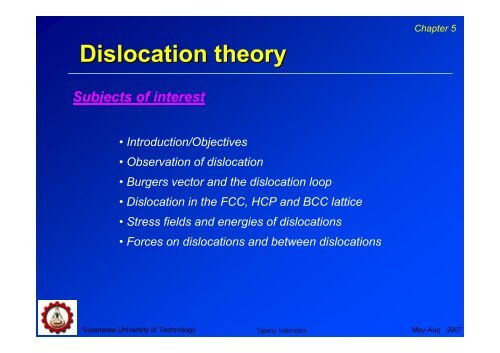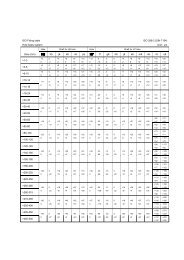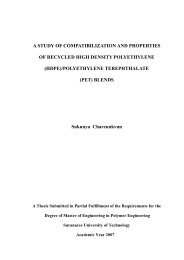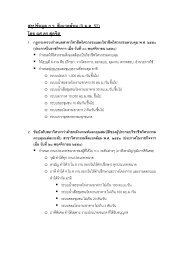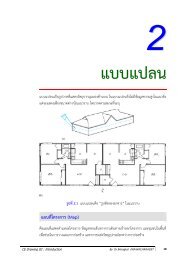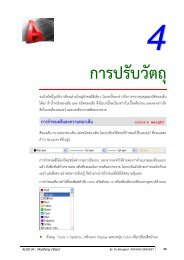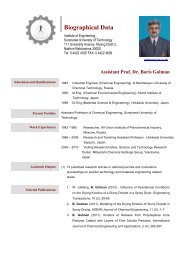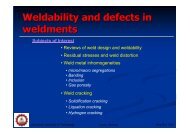Dislocation theory
Dislocation theory
Dislocation theory
Create successful ePaper yourself
Turn your PDF publications into a flip-book with our unique Google optimized e-Paper software.
<strong>Dislocation</strong> <strong>theory</strong><br />
Subjects of interest<br />
• Introduction/Objectives<br />
• Observation of dislocation<br />
• Burgers vector and the dislocation loop<br />
• <strong>Dislocation</strong> in the FCC, HCP and BCC lattice<br />
• Stress fields and energies of dislocations<br />
• Forces on dislocations and between dislocations<br />
Chapter 5<br />
Suranaree University of Technology May-Aug 2007<br />
Tapany Udomphol
<strong>Dislocation</strong> <strong>theory</strong><br />
Subjects of interest (continued)<br />
• <strong>Dislocation</strong> climb<br />
• Intersection of dislocations<br />
• Jogs<br />
• <strong>Dislocation</strong> sources<br />
• Multiplication of dislocations<br />
• <strong>Dislocation</strong>-point defect interactions<br />
• <strong>Dislocation</strong> pile-ups<br />
Chapter 5<br />
Suranaree University of Technology May-Aug 2007<br />
Tapany Udomphol
Objectives<br />
• This chapter emphasises the understanding of the<br />
effects of dislocation behaviour on FCC, BCC and HCP<br />
crystal structures.<br />
• This includes the interaction of dislocations such as<br />
climb, jogs, intersection and multiplication of dislocations<br />
and the roles of dislocations on plastic deformation of<br />
metals.<br />
Suranaree University of Technology May-Aug 2007<br />
Tapany Udomphol
Introduction<br />
<strong>Dislocation</strong>s introduce imperfection into the structure and therefore<br />
these could explain how real materials exhibit lower yield stress value<br />
than those observed in <strong>theory</strong>.<br />
<strong>Dislocation</strong>s<br />
51450 x<br />
Produce<br />
imperfection in<br />
crystal structures<br />
• Lower the yield stress from<br />
theoretical values.<br />
• Produce plastic deformation<br />
(strain hardening).<br />
• Effects mechanical properties<br />
of materials.<br />
Suranaree University of Technology May-Aug 2007<br />
Tapany Udomphol
Observation of dislocations<br />
A variety of techniques have been used to observe dislocations in<br />
the past 20 years to aid the better understanding of dislocation<br />
behaviour.<br />
Chemical (etch–pit) technique<br />
• Using etchant which forms a pit at the<br />
point where a dislocation intersect the<br />
surface.<br />
• Preferential sites for chemical attack are<br />
due to strain field around dislocation sites<br />
(anodic).<br />
• Can be used in bulk samples but limited in<br />
low dislocation density crystal (10 4 mm -2 ).<br />
Note: Pits are 500 A o apart and with<br />
the dislocation density of 10 8 mm -2 .<br />
5000 x<br />
Etch pits on slip bands in alpha<br />
brass crystals<br />
Suranaree University of Technology May-Aug 2007<br />
Tapany Udomphol
Decoration of dislocation technique<br />
A small amount of impurity is added to form precipitates after<br />
suitable heat treatment to give internal structure of the<br />
dislocation lines.<br />
• Hedges and Mitchell first used<br />
photolytic to decorate dislocation in<br />
AgBr.<br />
• Rarely used in metals but in ironic<br />
crystals such as AgCl, NaCl, KCl<br />
and CaF 2 .<br />
Hexagonal network of dislocations<br />
in NaCl detected by a decoration<br />
technique.<br />
Suranaree University of Technology May-Aug 2007<br />
Tapany Udomphol
Transmission electron microscope (TEM)<br />
TEM is the most powerful technique used to study dislocations.<br />
• A thin foil of 100 nm is prepared using<br />
electropolishing from a ~1 mm thick sheet.<br />
• This thin foil is transparent to electrons in<br />
the electron microscope and this makes it<br />
possible to observed dislocation<br />
networks, stacking faults, dislocation<br />
pile-ups at grain boundaries.<br />
• By using the kinematic and dynamic<br />
theories of electron diffraction it is possible<br />
to determine the dislocation number,<br />
Burgers vectors and slip planes.<br />
32500 x<br />
<strong>Dislocation</strong> network in cold-worked<br />
aluminium.<br />
Note: The sampling area is small therefore the properties<br />
observed cannot represent the whole materials.<br />
Suranaree University of Technology May-Aug 2007<br />
Tapany Udomphol
X-ray ray microscopy<br />
• Using an X-ray technique to detect dislocation structure.<br />
• The most common techniques are the Berg-Barret reflection<br />
method and the Lang topography method.<br />
• The resolution is limited to 10 3 dislocations/mm 2 .<br />
Suranaree University of Technology May-Aug 2007<br />
Tapany Udomphol
Burgers vector and the<br />
dislocation loop<br />
Burgers vector is the most<br />
characteristic feature of a<br />
dislocation, which defines the<br />
magnitude and the direction of slip.<br />
• Edge Burgers vector is to the<br />
dislocation line.<br />
• Screw Burgers vector is // to the<br />
dislocation line.<br />
• Both shear stress and final<br />
deformation are identical for both<br />
situations.<br />
Macroscopic deformation produced by glide of<br />
(a) edge dislocation and (b) screw dislocation.<br />
Note: Most dislocations found in crystalline materials are<br />
probably neither pure edge or pure screw but mixed.<br />
Suranaree University of Technology May-Aug 2007<br />
Tapany Udomphol
<strong>Dislocation</strong> loops<br />
<strong>Dislocation</strong>s in single crystals are straight lines. But in general,<br />
dislocations appear in curves or loops, which in three<br />
dimensions form and interlocking dislocation network.<br />
• Any small segments of the dislocation<br />
can be resolved into edge and screw<br />
components.<br />
• Ex: pure screw at point A and pure edge<br />
at point B where along most of its length<br />
contains mixed edge and screw. But with<br />
the same Burgers vector.<br />
<strong>Dislocation</strong> loop lying in<br />
a slip plane.<br />
Suranaree University of Technology May-Aug 2007<br />
Tapany Udomphol
Burgers circuit<br />
Burgers circuit is used to define the Burgers vector of dislocation.<br />
(a)<br />
Burgers circuits<br />
around edge<br />
dislocation<br />
(b)<br />
Burgers circuits<br />
around screw<br />
dislocation<br />
• If we trace a clockwise path from start to finish, the closure<br />
failure from finish to start is the Burgers vector b of the<br />
dislocation, see fig (a).<br />
• A right-handed screw dislocation, fig (b), is obtained<br />
when transversing the circuit around the dislocation line and<br />
we then have the helix one atomic plane into the crystal.<br />
Suranaree University of Technology May-Aug 2007<br />
Tapany Udomphol
Cross slip<br />
In FCC cubic metals, the screw dislocations move in {111} type<br />
planes, but can switch from one {111} type plane to another if it<br />
contains the direction of b. This process is called cross-slip.<br />
<strong>Dislocation</strong><br />
S<br />
Cross slip in a face-centred cubic crystal.<br />
Cross slip on the polished surface<br />
of a single crystal of 3.25% Si iron.<br />
• A screw dislocation at S is free to<br />
glide in either (111) or (111)<br />
closed-packed planes.<br />
• Double cross slip is shown in (d).<br />
Suranaree University of Technology May-Aug 2007<br />
Tapany Udomphol
<strong>Dislocation</strong> dissociation<br />
<strong>Dislocation</strong> dissociation occurs when the strength of<br />
dislocation is more than unity. The system becomes unstable<br />
dislocation therefore dissociate into two dislocation.<br />
Note: <strong>Dislocation</strong> of unit strength is a dislocation with a Burgers<br />
vector equal to one lattice spacing.<br />
The dissociation reaction b 1 b 2 + b 3 will occur<br />
when b 1 2 > b2 2 + b3 2 .<br />
• A dislocation of unit strength has a minimum energy<br />
when its Burgers vector is parallel to a direction of closest<br />
atomic packing.<br />
• In close-packed lattices, dislocations with strength less<br />
than unity are possible. therefore crystals always slip in<br />
the close-packed direction.<br />
Suranaree University of Technology May-Aug 2007<br />
Tapany Udomphol
<strong>Dislocation</strong>s in FCC lattice<br />
• Slip occurs in the FCC lattice on the {111} plane in the direction<br />
and with a Burgers vector (a/2)[110].<br />
• The {111} planes are stacked on a close packed sequence ABCABC<br />
and vector b = (ao /2)[101] defines one of the observed slip direction,<br />
which can favourably energetically decompose into two partial<br />
dislocations.<br />
b<br />
1<br />
a<br />
o<br />
2<br />
→ b<br />
2<br />
[ 101]<br />
+ b<br />
→<br />
3<br />
a<br />
o<br />
6<br />
a<br />
o [ 211]<br />
+ [ 112]<br />
Shockley partials<br />
This Shockley partials creates a<br />
stacking fault ABCAC/ABC.<br />
6<br />
Extended dislocation<br />
Fully slipped<br />
Faulted<br />
region<br />
No slip<br />
Dissociation of a dislocation to<br />
two partial dislocations.<br />
Suranaree University of Technology May-Aug 2007<br />
Tapany Udomphol
Dissociation of a dislocation into two<br />
partial dislocations<br />
• The combination of the two partials AC and<br />
AD is known as an extended dislocation.<br />
• The region between them is a stacking<br />
fault which has undergone slip.<br />
• The equilibrium of these partial dislocations<br />
depends on the stacking fault energy.<br />
Group of stacking fault in 302 stainless<br />
steel stopped at boundary<br />
Extended dislocation<br />
Fully slipped<br />
Faulted<br />
region<br />
No slip<br />
www.msm.cam.ac.uk<br />
Stacking fault<br />
Suranaree University of Technology May-Aug 2007<br />
Tapany Udomphol
Stacking faults<br />
The wider region between partial dislocation,<br />
the lower stacking fault energy<br />
• Characteristics of metals with<br />
low SPF;<br />
1) Easy to strain harden<br />
2) Easy for twin annealing to occur<br />
3) Temperature dependent flow<br />
stress<br />
• Aluminium – high stacking fault energy<br />
more likely to cross slip.<br />
• Copper – lower stacking fault energy <br />
cross slip is not prevalent.<br />
Partial<br />
dislocations<br />
Stacking fault<br />
Typical values of stacking fault energy<br />
Metal Stacking fault energy (mJ m -2 )<br />
Brass<br />
303 stainless steel<br />
304 stainless steel<br />
310 stainless steel<br />
Silver<br />
Gold<br />
Copper<br />
Nickel<br />
Aluminium<br />
Slip plane<br />
Model of a stacking fault.<br />
Suranaree University of Technology May-Aug 2007<br />
Tapany Udomphol<br />
Frank partial dislocations<br />
Frank partial dislocations are<br />
another type of partial dislocation in<br />
FCC lattice, which provide<br />
obstacles to the movement of other<br />
dislocations.<br />
Frank partial dislocation or sessile<br />
dislocation.<br />
• A set of (111) plane (viewed from the edge) has a missing middle A<br />
plane with a Burgers vector (a o /3) [111] perpendicular to the central<br />
stacking fault.<br />
• Unlike perfect dislocation, Frank partial dislocation cannot move<br />
by glide (sessile dislocation) but by diffusion of atom.<br />
Suranaree University of Technology May-Aug 2007<br />
Tapany Udomphol
Lomer-Cortrell barrier<br />
Intersection of {111} plane during<br />
duplex slip by glide of dislocations is<br />
called Lomer-Cortrell barrier.<br />
Ex: consider two perfect dislocations<br />
lying in different {111} planes and<br />
both parallel to the line of intersection<br />
of the {111} plane.<br />
a<br />
o<br />
2<br />
[ 101]<br />
+<br />
a<br />
o<br />
2<br />
[ 110]<br />
[ 011]<br />
Lomer-Cortrell barrier<br />
The new dislocation obtained has reduced energy.<br />
→<br />
Suranaree University of Technology May-Aug 2007<br />
a<br />
o<br />
2<br />
Tapany Udomphol
<strong>Dislocation</strong>s in HCP lattice<br />
• Slip occurs in the HCP lattice on the basal (0001) plane in the<br />
direction.<br />
• The basal (0001) plane the close packed of a sequence ABABAB<br />
and a Burgers vector b = (a o /3)[1120].<br />
• <strong>Dislocation</strong>s in the basal plane can reduce their energy by<br />
dissociating into Shockley partials according to the reaction.<br />
a<br />
o<br />
3<br />
[ 1120]<br />
→<br />
a<br />
o<br />
3<br />
[ 1010]<br />
[ 0110]<br />
The stacking fault produced by this reaction lies in the basal<br />
plane, and the extended dislocation which forms it is confined to<br />
glide in this plane.<br />
Suranaree University of Technology May-Aug 2007<br />
+<br />
a<br />
o<br />
3<br />
Tapany Udomphol
<strong>Dislocation</strong>s in BCC cubic lattice<br />
• Slip occurs in the BCC lattice on {110}, {112}, {123} planes in the<br />
direction and a Burgers vector b = (a o /2)[111].<br />
Cottrell has suggested a dislocation reaction which appears to cause<br />
immobile dislocations. (ao /2[001] in iron) leading to a crack<br />
nucleus formation mechanism for brittle fracture.<br />
a<br />
o<br />
2<br />
[ 111]<br />
+<br />
a<br />
o<br />
2<br />
[ 111]<br />
→<br />
the dislocation is immobile since<br />
the (001) is not a close-packed slip<br />
plane, the (001) plane is therefore<br />
the cleavage plane when brittle<br />
fracture occurs.<br />
a<br />
o<br />
[ 001]<br />
b = a[<br />
001]<br />
a<br />
[ 111]<br />
2<br />
a<br />
[ 111]<br />
2<br />
(101) Slip plane<br />
(101) Slip plane<br />
Applied stress<br />
(001) Cleavage plane<br />
Slip on intersecting (110) plane.<br />
Suranaree University of Technology May-Aug 2007<br />
Tapany Udomphol<br />
a<br />
2<br />
σ<br />
σ<br />
a<br />
111<br />
2<br />
[ 111]<br />
+ [ ] → a[<br />
001]<br />
Cleavage knife crack of length c<br />
for displacement nb
Stress fields of dislocations<br />
A dislocation is surrounded by an elastic stress field that<br />
produces forces on other dislocations and results in interaction<br />
between dislocations and solute atoms.<br />
• The cross section of an elastic cylindrical<br />
piece (dashed line) has been distorted after<br />
an edge dislocation running through point O<br />
parallel to the z axis (blue line).<br />
• The strain is zero in the z axis and<br />
therefore can be treated in plane strain (x-y).<br />
• The stresses vary inversely with distance<br />
from the dislocation line and become<br />
infinite at r = 0.<br />
−τ<br />
ob<br />
sinθ<br />
…Eq. 1 σ r = σ θ =<br />
r<br />
• The shear stress ττττ xy is a maximum<br />
in the slip plane, when y = 0.<br />
2 2 ( x − y )<br />
2 2<br />
( x + y<br />
Suranaree University of Technology May-Aug 2007<br />
τ<br />
Tapany Udomphol<br />
xy<br />
= τ<br />
o<br />
bx<br />
y<br />
r<br />
P<br />
O<br />
Q<br />
θθθθ<br />
A’ A<br />
r o<br />
Deformation of a circle containing<br />
an edge dislocation.<br />
)<br />
2<br />
b<br />
x<br />
…Eq. 2
Strain energies of dislocations<br />
The strain energy involved in the<br />
formation of an edge dislocation can<br />
be estimated from the work involved in<br />
displacement the cut OA a distance b<br />
along the slip plane.<br />
U<br />
=<br />
2<br />
Gb<br />
ln<br />
4π ( 1−ν<br />
)<br />
The strain energy of a screw<br />
dislocation is given by<br />
U<br />
2<br />
Gb<br />
4π<br />
r<br />
r<br />
o<br />
r<br />
r<br />
1<br />
o<br />
…Eq. 3<br />
1<br />
= ln<br />
…Eq. 4<br />
Note: the total strain energy is the<br />
sum of elastic strain energy and<br />
the core energy of dislocation.<br />
Suranaree University of Technology May-Aug 2007<br />
y<br />
r<br />
P<br />
O<br />
Q<br />
θθθθ<br />
A’ A<br />
r o<br />
Deformation of a circle containing<br />
an edge dislocation.<br />
The dislocation energy per unit<br />
length simplifies to<br />
Tapany Udomphol<br />
2<br />
Gb<br />
U = …Eq. 5<br />
2<br />
b<br />
x
Forces on dislocation<br />
ds<br />
b<br />
dl<br />
Force acting on a dislocation line.<br />
• A dislocation line moving in the<br />
direction of its Burgers vector under the<br />
influence of a uniform shear stress ττττ.<br />
• The force per unit length of dislocation F ;<br />
dW<br />
F = = τb<br />
dlds<br />
…Eq. 6<br />
• This force is normal to the dislocation<br />
line at every point along its length and is<br />
directed toward the unslipped part of<br />
the glide plane.<br />
• The Burgers vector is constant along<br />
the curved dislocation line.<br />
Suranaree University of Technology May-Aug 2007<br />
Tapany Udomphol
Forces between dislocations<br />
• <strong>Dislocation</strong>s of opposite sign on the same slip plane will<br />
attract each other, run together, and annihilate each other.<br />
• <strong>Dislocation</strong>s of alike sign on the same slip plane will repel<br />
each other<br />
The radial force F r between<br />
two parallel screw dislocations<br />
Fr = τ θz<br />
b<br />
2<br />
Gb<br />
=<br />
2πr<br />
…Eq. 7<br />
Parallel screw (same sign) +<br />
Aniparallel screw (opposite sign) -<br />
The radial and tangential<br />
forces between two parallel<br />
edge dislocations<br />
F r<br />
2<br />
Gb 1<br />
2π<br />
( 1−ν<br />
) r<br />
2<br />
Gb sin 2θ<br />
2π<br />
( 1−ν<br />
) r<br />
Suranaree University of Technology May-Aug 2007<br />
=<br />
Tapany Udomphol<br />
, F<br />
θ<br />
=<br />
…Eq. 8
<strong>Dislocation</strong> climb<br />
<strong>Dislocation</strong> climb is a non conservative movement of dislocation<br />
where and edge dislocation can move out of the slip plane onto a<br />
parallel directly above or below the slip plane.<br />
• Climb is diffusion-controlled (thermal activated) and occurs more<br />
readily at elevated temperature. important mechanism in creep.<br />
• Positive direction of climb is when<br />
the edge dislocation moves upwards.<br />
Removing extra atom (or adding vacancy<br />
around ). Compressive force<br />
produces + climb.<br />
• Negative direction of climb is when<br />
the edge dislocation moves downwards.<br />
Atom is added to the extra plane. Tensile<br />
forces to produce – climb.<br />
(a) Diffusion of<br />
vacancy to edge<br />
dislocation.<br />
(b) <strong>Dislocation</strong><br />
climbs up one<br />
lattice spacing.<br />
Note: Glide or slip of a dislocation is the direction parallel to its<br />
direction whereas climb of dislocation is in the vertical direction.<br />
Suranaree University of Technology May-Aug 2007<br />
Tapany Udomphol
Intersection of dislocations<br />
The intersection of two dislocations produces a sharp<br />
break (a few atom spacing in length) in dislocation line.<br />
This break can be of two types;<br />
• Jog is a sharp break in the dislocation<br />
moving it out of the slip plane.<br />
• Kink is a sharp break in the dislocation line<br />
which remains in the slip plane.<br />
Note: <strong>Dislocation</strong> intersection mechanisms play an important<br />
role in the strain hardening process.<br />
Suranaree University of Technology May-Aug 2007<br />
Tapany Udomphol
Jogs and Kinks<br />
Jogs are steps on the dislocation which move it from one atomic<br />
slip plane to another.<br />
Kinks are steps which displace it on the same slip plane.<br />
(a), (b) Kinks in edge and<br />
screw dislocations<br />
(c), (d) Jogs in edge and<br />
screw dislocations.<br />
Suranaree University of Technology May-Aug 2007<br />
Tapany Udomphol
Intersection of two dislocations<br />
1) Intersection of two dislocations with<br />
Burgers vectors at right angle to each other.<br />
• An edge dislocation XY with Burgers vector b 1<br />
is moving on plane P xy and cuts through<br />
dislocation AB with Burgers vector b 2 .<br />
• The intersection causes jog PP’ in dislocation<br />
AB parallel to b 1 and has Burgers vector b 2 .<br />
and with the length of the jog = b 1 .<br />
• It can readily glide with the rest of dislocation.<br />
Note: b 1 is normal to AB and jogs AB, while<br />
b 2 is parallel to XY and no jog is formed.<br />
Intersection of two<br />
edge dislocations<br />
Suranaree University of Technology May-Aug 2007<br />
Tapany Udomphol<br />
b 2<br />
b 1
Intersection of two dislocations<br />
2) Intersection of two dislocations with<br />
Burgers vectors parallel to each other<br />
• Both dislocations are jogged.<br />
• The length of jog PP’ is b 1 and<br />
the length of jog QQ’ is b 2 .<br />
• The jogs both have a screw<br />
orientation and lie in the original<br />
slip plane. This is called Kink. <br />
not stable.<br />
Before<br />
intersection<br />
After<br />
intersection<br />
Intersection of edge dislocations<br />
with parallel Burgers vectors.<br />
Suranaree University of Technology May-Aug 2007<br />
Tapany Udomphol
Intersection of two dislocations<br />
3) Intersection of edge and<br />
screw dislocations.<br />
Intersection produces a jog with an<br />
edge orientation on the edge<br />
dislocation and a kink with an edge<br />
orientation on the screw dislocation.<br />
4) Intersection of two screw<br />
dislocations.<br />
The intersection produces jogs<br />
of edge orientation in both screw<br />
dislocations. very important in<br />
plastic deformation.<br />
Note: at temperature where climb<br />
cannot occur the movement of screw<br />
dislocation is impeded by jogs.<br />
Suranaree University of Technology May-Aug 2007<br />
Tapany Udomphol
Jogs<br />
• A stable jog length of the dislocation line energy of the crystal<br />
(a) Many intersections occur when a<br />
screw dislocation encounter a forest of<br />
screw dislocations. producing<br />
vacancy jogs and/or interstitial jogs.<br />
(b) Jogs act as pinning points and<br />
cause dislocations to bow out with<br />
the radius R when the shear stress<br />
ττττ is applied.<br />
(c) At some critical radius R c the ττττ<br />
required to further decrease R > the<br />
stress needed for non-conservative<br />
climb. Then the dislocation will move<br />
forward leaving a trail of vacancies<br />
(interstitials) behind each jog.<br />
(a) Straight dislocation under zero stress.<br />
(b) <strong>Dislocation</strong> bowed out in slip plane<br />
between the jogs due to applied shear stress.<br />
(c) Movement of dislocation leaving trails of<br />
vacancies behind the jogs.<br />
Movement of jogged screw dislocation<br />
Suranaree University of Technology Tapany Udomphol<br />
May-Aug 2007
Superjogs<br />
Superjog is a jog that has more than one atomic slip plane spacing high.<br />
As the stress increases, the dislocation bows out between the<br />
superjogs, generating dislocation dipoles and later break into<br />
isolated loops.<br />
(a) <strong>Dislocation</strong> dipole.<br />
(b) Elongated loop and<br />
jogged dislocation.<br />
(c) Row of small loops.<br />
Formation of dislocation loops from a dislocation dipole<br />
Suranaree University of Technology May-Aug 2007<br />
Tapany Udomphol
<strong>Dislocation</strong> Sources<br />
• All metals initially contain an appreciable number of<br />
dislocations produced from the growth of the crystal from<br />
the melt or vapour phase.<br />
• Gradient of temperature and composition may affect<br />
dislocation arrangement.<br />
• Irregular grain boundaries are believed to be responsible<br />
for emitting dislocations.<br />
• <strong>Dislocation</strong> can be formed by aggregation and collapse of<br />
vacancies to form disk or prismatic loop.<br />
• Heterogeneous nucleation of dislocations is possible from<br />
high local stresses at second-phase particles or as a result<br />
of phase transformation.<br />
Suranaree University of Technology May-Aug 2007<br />
Tapany Udomphol
Multiplication of dislocations<br />
Frank & Read proposed that dislocations<br />
could be generated from existing dislocations.<br />
• The dislocation line AB bulges out<br />
(A and B are anchored by impurities)<br />
and produces slip as the shear<br />
stress ττττ is applied.<br />
• The maximum ττττ for<br />
semicircle dislocation<br />
bulge, fig (b)<br />
Gb<br />
τ ≈ ≈<br />
2R<br />
Gb<br />
l<br />
• Beyond this point, the dislocation loop<br />
continues to expand till parts m and n<br />
meet and annihilate each other to form a<br />
large loop and a new dislocation.<br />
Note: Repeating of this process producing a<br />
dislocation loop, which produces slip of one<br />
Burgers vector along the slip plane.<br />
The operation of Frank-Read source<br />
Frank Read source in a silicon crystal<br />
Suranaree University of Technology May-Aug 2007
<strong>Dislocation</strong>-point <strong>Dislocation</strong> point defect interactions<br />
Point defect and dislocation will interact elastically and<br />
exert forces on each other.<br />
If the solute atom is<br />
larger than the<br />
solvent atom (εεεε > 1)<br />
If the solute atom is<br />
smaller than the<br />
solvent atom (εεεε < 1)<br />
Negative interaction energy attraction<br />
Positive interaction energy repulsion<br />
The atom will be repelled from the<br />
compressive side of a positive edge<br />
dislocation and will be attracted to the<br />
tension side.<br />
The atom will be attracted to the<br />
compression side.<br />
• Vacancies will be attracted to regions of compression.<br />
• Interstitials will be collected at regions of tension.<br />
Suranaree University of Technology May-Aug 2007<br />
Tapany Udomphol
<strong>Dislocation</strong> pile-ups pile ups<br />
<strong>Dislocation</strong>s often pile up<br />
on slip planes at barriers<br />
i.e., grain boundaries or<br />
second phase particles.<br />
High stress concentration on the<br />
leading dislocations in the pile-up.<br />
If the pile-up stress > theoretical shear stress yielding<br />
A pile-up of n dislocations along<br />
a distance L can be considered<br />
as a giant dislocation with a<br />
Burgers vector nb.<br />
<strong>Dislocation</strong> pile-ups at an obstacle.<br />
The breakdown of a barrier occur by<br />
1) Slip on a new plane.<br />
2) Climb of dislocation around the<br />
barrier.<br />
3) Generation of high enough tensile<br />
stress to produce a crack.<br />
Suranaree University of Technology May-Aug 2007<br />
Tapany Udomphol
References<br />
• Dieter, G.E., Mechanical metallurgy, 1988, SI metric edition,<br />
McGraw-Hill, ISBN 0-07-100406-8.<br />
• Sanford, R.J., Principles of fracture mechanics, 2003, Prentice<br />
Hall, ISBN 0-13-192992-1.<br />
• W.D. Callister, Fundamental of materials science and<br />
engineering/ an interactive e. text., 2001, John Willey & Sons, Inc.,<br />
New York, ISBN 0-471-39551-x.<br />
• Hull, D., Bacon, D.J., Introduction to dislocations, 2001, Forth<br />
edition, Butterworth-Heinemann, ISBN 0-7506-4681-0.<br />
Suranaree University of Technology May-Aug 2007<br />
Tapany Udomphol


